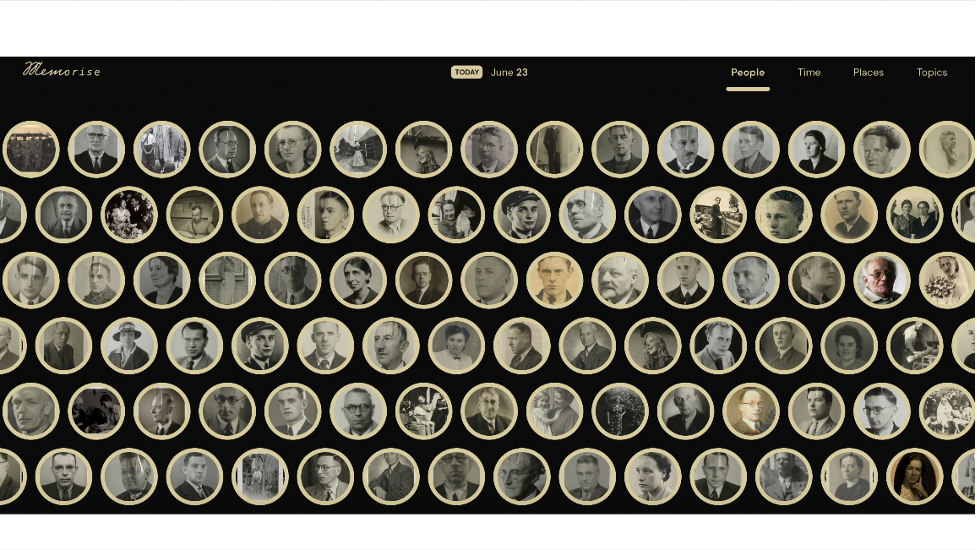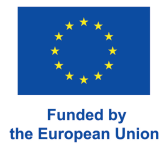Diversity and Inclusion in the Development and Design of Digital Projects
By Esther Rachow
On an early-spring morning in late February, the MEMORISE teams of the Bergen-Belsen Memorial (Stephanie Billib and Charlotte Trottier) and the Hebrew University of Jerusalem (Tobias Ebbrecht-Hartmann, Esther Rachow and Noga Stiassny) were waiting on Zoom for dozens of experts and colleagues from all over Europe and Israel to join their interactive one-day workshop. The topic? Accessibility, diversity, and inclusion in heritage projects on Nazi Persecution.

Professor Stefan Jänicke, head of the Centre for Digital Humanities at the University of Southern Denmark and Project Coordinator of MEMORISE opened the day with his keynote lecture on “Digital Inclusion in Computer-Based Meta-Data Visualization”. Through an interactive exploration of the different identities included among the group of workshop participants, Jänicke underlined the difficulty of defining the ‘limits of diversity’.
His insights provided a critical understanding of the blind spots in data visualization and emphasized the necessity to avoid cliches, stereotypes, and miss- or pre-conceptions for an inclusive meta-data visualization.
After the localisation of the topic within the field of digital humanities the Vice President for Strategy and Diversity at the Hebrew University of Jerusalem, Professor Mona Khoury, discussed a different, complex question, of representation. She works hands-on at strategies of inclusion at the predominantly mixed Jewish and Arab Hebrew U, Israel’s biggest and most diverse University. In her keynote “Diversity and Inclusion in Academia” she explained how. Their main approach is one that focuses less on the ethnicity or religion of a student, but on whether a student is a first-generation academic. By identifying the challenges of this particular group, they can include most of the minority groups of the University in an active and holistic framework for support without stigmatizing them. Charlotte Trottier is an Educational Assistant at the Bergen-Belsen Memorial. In a third keynote, Trottier delivered an outlook on the practical implementation of “Design for All and Inclusion at Memorials and in Historical-Political Education”. She explained how “Design for All” includes a multidisciplinary, user-centered approach to the process of the development of educational materials, exhibitions, and other representations of historical heritage sites. She specifically mentions the importance of an active and professional (paid!) participation of actors representing different abilities and disabilities in the design process.
In their input, the Hebrew University team led by Professor Tobias Ebbrecht-Hartmann and the two co-organizers Dr. Noga Stiassny and Esther Rachow concluded how concepts of diversity, inclusivity and accessibility inform historical narratives, societal discourse, work environments and digital technologies.

But, how do they influence the MEMORISE project? “The MEMORISE project has decided to place a special focus on fostering empathy and emotional engagement with the heritage of Nazi persecution by bringing to life personal stories and subjective experiences shared in diaries, paintings, and other personal sources and artifacts. Using innovative computer-based visualization techniques this approach is central to our newly established conceptual and ethical principles for visualizing heritage on Nazi persecution” Ebbrecht-Hartmann explains.
By keeping in mind how digital technologies have the tendency to amplify social biases, historical research can lead to exclusive master narratives, work environments are dominated by visible and invisible social in- and exclusion and societies tend to suppress or re-write their difficult heritage, the participants were invited to an interactive workshop phase – reflecting on those four fields, constituting MEMORISE.

Who thinks this ended up in a linear discussion, has never been to a reversed-brainstorming session. By asking what creates an unwelcoming and exclusive space, the participants were enabled to define the key factors and obstacles for inclusion to then translate them into guiding principles for successful inclusivity.
Through answering the concluding question of “How can we make a space feel inclusive and welcoming to all?” the following aspects were noted:
Digital Technologies
- Create a digital welcoming culture
- Create accessible terminology, through personalized information systems
- Work interdisciplinary on design
- Work with intuitive design: clarity & familiarity
- Do user tests and evaluate
- Increase technical inclusiveness: device-independent & multimodal
- Foster digital literacy
Historical Narratives
- Include various mnemonic agents in the design process
- Promote and guide best practices
- Create content interactively and equally together with different community actors and stakeholders
- Interpret history through the lens of diversity: multilingual, transnational, complexity of identities etc.
- Develop concepts for inclusive historical narratives on related topics: forced migration, new beginnings, stigmatization etc.
- Tell story in a trauma informed way
- Put the human in the center of the narrative
- Highlight historical continuities
- Foster empathy through personalized narratives
- Place history in the context of today’s societies
Heritage and Data Preservation
- Create a children’s space
- Have breakout spaces
- Invite multiperspectivity
- Offer adjustable furniture
- Create multi sensual material
- Provide easy language
Work Environment
- Provide higher budgets for more flexibility
- Increase participation in workflow
- Try to understand different perspectives within the team
- Empower people to deal with the challenges of the institution
- Open communication on accessibility
- Open opportunity to participate in institutional discourse
- Explain work well
- Offer opportunities for easy language
- Put individuals in the center
- Create a welcoming atmosphere
- Be flexible
The interdisciplinary and international collaboration of this workshop helped MEMORISE to reflect and phrase important standards for guidelines on accessibility and inclusivity to work on creating a culture based on the principles of diversity, both within its working environment and as part of its research goals.
Statement on diversity & inclusion
The workshop resulted in a statement that defines the MEMORISE code of conduct regarding accessing heritage related to Nazi persecution, and diversity & inclusion in the development and design of digital projects:
As an international and interdisciplinary research project, MEMORISE is committed to creating an inclusive digital environment in which the tangible and intangible Heritage related to Nazi Persecution (HNP) is universally accessible as part of a shared and multi-layered heritage. We acknowledge the dual nature of digital technology: its immense potential to facilitate new avenues for engagement with, and exploration of, HNP through the lens of Diversity & Inclusion, as well as the new ethical challenges it presents. Our approach is therefore informed by the principle of ‘design for all’ which we apply to the digital realm in order to enhance digital literacy and empower users to actively engage with historical and heritage narratives of Nazi persecution in ways that highlight the transnational and cross-generational dimension of HNP. Guided by the ‘design for all’ principle, our digital applications address the varied needs of diverse users across ages and locations, and cover a comprehensive array of conceptual, methodological, and curatorial strategies. Their user-centric intuitive design consciously avoids the over-categorization of victims and counters discriminatory racial divisions, offering accessible language, multilingual options, and providing multiple points of contact with HNP that resonate with the experiences of individuals and groups from the past and in today’s world. We view the development of a diversity and inclusion-driven digital environment as an ongoing journey. We remain dedicated to continual learning, adaptation, feedback, and further exploration in our endeavor to establish a truly welcoming digital culture.
Online lecture series on diversity & inclusion
The MEMORISE team at the Hebrew University of Jerusalem organised an online lecture series on “Accessing Heritage related to Nazi Persecution: Diversity & Inclusion in the Development and Design of Digital Projects”:
6.11.2024, 18:00-19:00 CET: Understanding Inclusive Digital Heritage Related to Nazi Persecution
20.11.2024, 18:00-19:00 CET: ‘Design For All’: Implementing Inclusive Digital Heritage Related to Nazi Persecution
4.12.2024, 18:00-19:00 CET: Technology’s Role in Inclusive Digital Heritage Related to Nazi Persecution
18.12.2024, 18:00-19:00 CET: The Future of Inclusive Digital Heritage



No responses yet